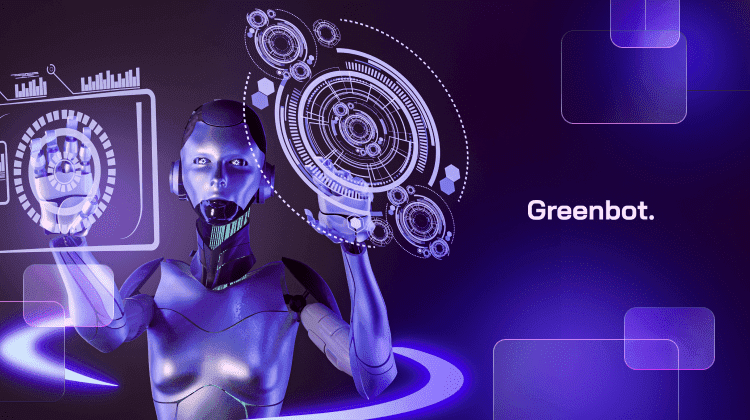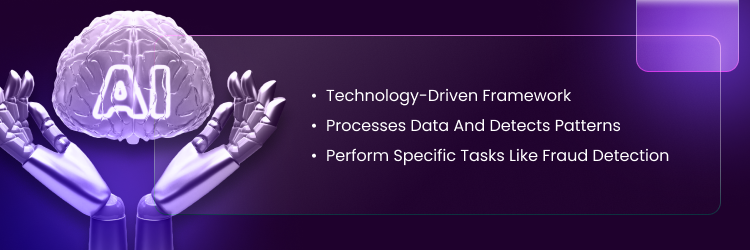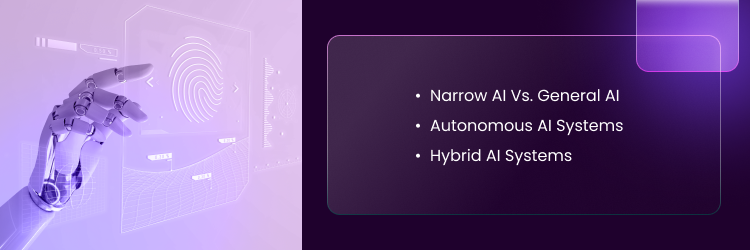
AI systems analyze data, detect patterns, and automate decisions with minimal input. They improve healthcare, finance, and cybersecurity efficiency, power fraud detection, self-driving cars, and personalized recommendations. AI transforms industries by handling complex tasks faster than humans as they evolve.
This guide explores how AI systems work, their components, and their real-world impact.
Understanding AI Systems

AI System Definition
An AI system is a technology-driven framework that processes data and detects patterns. It operates independently, making decisions without continuous human input. AI learns from new data and adjusts its outputs using automated models.
These systems perform specific tasks like fraud detection, medical diagnostics, and personalized recommendations. According to the World Economic Forum (WEF), automated decision-making enhances industry efficiency.
While artificial intelligence explores smart machine capabilities, AI systems focus on real-world problem-solving. Their key elements include learning models, real-time adaptation, and predictive analysis.
Learn more about AI in this guide on What is AI.
How AI Systems Work
AI systems function in three main stages: data processing, learning, and decision-making.
Data Processing
AI systems gather, clean, and analyze text, images, and sensor data. Quality data is critical for accuracy. The system can make biased or unreliable predictions if the input is flawed. AI systems use data filtering and preprocessing techniques to remove inconsistencies and improve reliability.
Learning Algorithms
After processing data, AI applies learning techniques to detect patterns and improve accuracy. These models evolve by analyzing past information and adjusting predictions. Over time, this continuous learning enhances AI’s ability to handle complex tasks efficiently.
Decision-Making
AI systems process results to generate insights, automate tasks, and support human decisions. They improve by reviewing past outcomes, identifying errors, and refining future predictions. This continuous learning helps AI systems operate in real-time. Self-driving cars adjust to road conditions instantly, and financial models analyze data to predict market trends.
AI Systems vs. Traditional Software
Traditional software follows fixed rules and requires manual updates to adapt to new conditions. It performs tasks precisely as programmed and cannot improve without human intervention.
AI systems, on the other hand, analyze data in real time, adapt to new patterns, and automate decision-making without constant updates. This makes AI essential for predictive analytics, fraud detection, and cybersecurity, where flexibility and learning are crucial.
Key Components of an AI System
AI systems use data, learning models, and automation to make accurate decisions. These components help AI adapt, improve, and refine performance over time.
Data and Data Processing
AI systems need high-quality data to function correctly. The process involves three key steps:
- Data Collection: AI gathers information from sensors, databases, and websites. The quality and diversity of this data affect how well AI detects patterns.
- Data Cleaning: AI removes errors, duplicates, and inconsistencies to ensure reliable results. Poor data leads to inaccurate predictions.
- Data Analysis: AI examines data to find trends, relationships, and anomalies. This is critical for tasks like facial recognition, speech processing, and self-driving cars.
Machine Learning Algorithms
AI learns by analyzing data and improving over time. The main learning methods include:
- Supervised Learning: AI is trained with labeled data and uses it for speech recognition, chatbots, and fraud detection.
- Unsupervised Learning: AI finds hidden patterns in customer segmentation and recommendation engines.
- Reinforcement Learning: AI improves through trial and error and is used in self-driving cars and robotics.
Neural Networks & Deep Learning
Neural networks help AI recognize patterns, analyze data, and automate decisions. These systems work like the human brain, processing large datasets to improve accuracy.
Deep learning, a subset of neural networks, is used in image recognition, natural language processing (NLP), and real-time automation. Industries like healthcare, finance, and cybersecurity use deep learning to detect fraud, diagnose diseases, and prevent cyber threats.
AI Models and Training
AI models train on large datasets to improve accuracy. They learn by identifying patterns and refining predictions over time.
Once trained, models go through fine-tuning and optimization to remove bias, improve accuracy, and ensure reliable performance in real-world applications.
Human-AI Interaction
AI is part of everyday life. It helps with directions, voice assistants, and automated customer support. These tools handle routine tasks, making work easier and faster.
AI also helps businesses, doctors, and researchers analyze large data sets, improve decision-making, and streamline complex tasks. As AI improves, it will better understand speech, gestures, and behaviors, making interactions smoother and more human-like.
Types of AI Systems

AI systems vary based on capabilities and functions. Some focus on specific tasks, while others aim for broader intelligence.
Narrow AI vs. General AI
Narrow AI (Weak AI) specializes in one task. It powers voice assistants, fraud detection, and recommendation engines. Examples include Siri, Alexa, and ChatGPT. These systems cannot operate beyond their programmed scope.
General AI (AGI) is a theoretical concept. It would think, learn, and adapt like a human, applying knowledge across different fields. No AGI models exist yet, but researchers are exploring its possibilities.
Autonomous AI Systems
Autonomous AI operates with minimal human input. It uses real-time data to adapt and make decisions instantly.
Examples:
- Self-driving cars detect roads, traffic, and obstacles.
- Industrial robots automate tasks in manufacturing and healthcare.
While advancing, complete independence remains challenging, requiring human oversight in complex environments.
Hybrid AI Systems
Hybrid AI combines multiple techniques for better adaptability. It integrates:
- Symbolic AI: Uses predefined rules and logic to process information.
- Machine Learning: Learns from patterns and improves over time.
- Expert Systems: Mimic human decision-making using knowledge bases.
Example: IBM Watson blends rule-based logic, machine learning, and NLP to assist in healthcare, finance, and customer service.
Hybrid AI is gaining popularity, offering structured reasoning with adaptive learning to solve complex problems.
Real-World Applications of AI Systems
AI impacts multiple industries, improving efficiency and decision-making.
AI in Space Exploration
AI improves autonomy and data analysis in space missions. NASA’s Perseverance rover navigates Mars independently, detecting terrain hazards and planning routes. This reduces risks and enhances mission success.
AI also analyzes satellite images to identify celestial bodies and cosmic events. It helps optimize spacecraft routes, reducing fuel use and ensuring precise navigation. As research advances, AI will assist in deep-space exploration and interplanetary travel.
AI in Environmental Science
AI helps track climate trends, predict disasters, and manage resources. Climate models analyze temperature shifts, extreme weather, and rising sea levels to improve environmental planning.
AI also enhances disaster response by detecting wildfires, floods, and hurricanes through satellite imagery. It optimizes energy grids, monitors water usage, and improves electricity distribution, preventing shortages and improving sustainability.
AI in Education
AI personalizes learning by adjusting lessons based on student progress. Adaptive platforms offer customized feedback, strengthening weak areas and improving comprehension.
AI automates grading and assessments, reducing manual work. Virtual tutors and AI chatbots provide real-time support, making education more accessible. As AI advances, it will expand interactive learning tools and increase global access to quality education.
AI in Entertainment
AI enhances content discovery, gaming, and filmmaking. Streaming platforms analyze user behavior to recommend movies, music, and shows, improving engagement.
In gaming, AI creates realistic characters and environments. Films use AI for lifelike animations and digital effects. While deepfake technology is controversial, it plays a growing role in filmmaking and digital storytelling.
Challenges and Ethical Considerations
Bias in AI Systems
AI can develop biases if trained on imbalanced or flawed data. This affects hiring, loans, and criminal justice, sometimes reinforcing inequalities.
Developers use explainable AI (XAI) and bias-reduction techniques to improve fairness. However, ethical AI goes beyond data—it requires accountability, transparency, and continuous oversight to prevent discrimination.
Privacy and Security Risks
AI processes large amounts of personal data, raising concerns about privacy breaches and unauthorized access. Facial recognition, predictive analytics, and surveillance tools collect sensitive user information, sometimes without consent.
Weak security makes AI systems vulnerable to cyberattacks. Hackers can manipulate models, steal data, or spread misinformation. To reduce risks, encryption, strict regulations, and AI-driven threat detection help secure user data and prevent misuse.
AI and Job Displacement
AI automates repetitive tasks, increasing efficiency in manufacturing, customer service, and administration. While this reduces the demand for certain jobs, it also creates new roles in AI system management, cybersecurity, and data science.
Governments and businesses invest in reskilling programs to help workers transition into AI-related jobs. Responsible AI adoption ensures automation improves productivity without mass job losses, balancing technology with human expertise.
The Future of AI Systems
AI is advancing rapidly, with major developments in machine learning, generative AI, and AI regulations shaping its future.
Advances in AI Technologies
Generative AI is evolving to become faster, smaller, and more efficient. Projects like Llama 3.1 and Mistral Large 2 improve collaboration in AI research. These models refine content creation, automate workflows, and enhance personalization.
Quantum computing is revolutionizing AI by solving complex problems at record speeds. This breakthrough will impact cryptography, drug discovery, logistics, and financial modeling, making AI more powerful and efficient than ever.
AI Regulations and Policies
Governments worldwide are setting AI safety laws to protect users and prevent misuse.
- The EU’s AI Act (2026) mandates transparency, fairness, and accountability in AI systems and regulates biometric surveillance and automated decision-making.
- The U.S. AI Bill of Rights promotes privacy and security standards, focusing on industry-led guidelines rather than strict regulations.
- China enforces deepfake regulations, requiring companies to label AI-generated content and disclose its use.
By 2034, global cooperation will shape AI governance, with organizations like the OECD and the United Nations developing ethical frameworks for AI’s safe adoption.
FAQs
What are AI systems used for?
AI powers healthcare, finance, and cybersecurity. It automates tasks, enhances data analysis, and improves decision-making. Machine learning models detect fraud, optimize supply chains, and personalize user experiences.
How do AI systems learn?
AI learns by analyzing large datasets. Neural networks identify patterns, while deep learning refines predictions. This improves speech recognition, image processing, and predictive analytics.
What are the risks of AI systems?
AI poses risks like bias, privacy concerns, and security threats. Poor-quality data can lead to unfair outcomes, while weak security raises worries about unauthorized access. Responsible AI practices ensure fairness and safety.
Are AI systems replacing humans?
AI automates routine tasks but does not replace human creativity or critical thinking. It enhances customer service, data analysis, and manufacturing productivity, while humans remain essential for decision-making and innovation.
How do I develop an AI system?
Building AI requires data collection, model training, and testing. Developers refine accuracy using computer science principles. High-quality datasets and continuous evaluation are key to optimizing AI performance.
How does AI work?
An artificial intelligence system processes new data using machine learning algorithms to improve over time. It relies on training data, artificial neural networks, and deep neural networks to detect patterns. AI powers computer vision, speech recognition systems, and virtual assistants, making AI and machine learning essential for handling complex problems and enhancing human capabilities.
What makes AI different from traditional software?
Unlike computer systems that follow fixed rules, AI software adapts by analyzing historical data and learning from mistakes. Machine learning techniques help AI improve decision-making, making it more flexible than standard programs. AI automates repetitive tasks, supports quality control, and enhances industries like healthcare AI and security. It refines human language processing and solves complex system challenges in real time.
Can AI think like a human?
AI can simulate human intelligence but lacks its own existence or independent thought. It processes human language using generative AI tools but doesn’t experience emotions or awareness. Strong AI—which would match human capabilities—remains theoretical. AI improves performing tasks, automates workflows, and enhances facial recognition systems but does not achieve full human-like reasoning.
AI Systems: Conclusion
AI systems are transforming industries by automating tasks, improving decision-making, and enhancing efficiency in areas like healthcare, finance, and cybersecurity. With advancements in machine learning and deep learning, these systems continue to evolve, making them essential for data analysis and predictive insights.
However, AI systems also pose challenges like bias, transparency, and security risks. To ensure ethical development, global regulations and responsible AI practices are crucial. As technology advances, integrating AI with quantum computing and generative models will unlock new possibilities while ensuring it complements human intelligence.






















